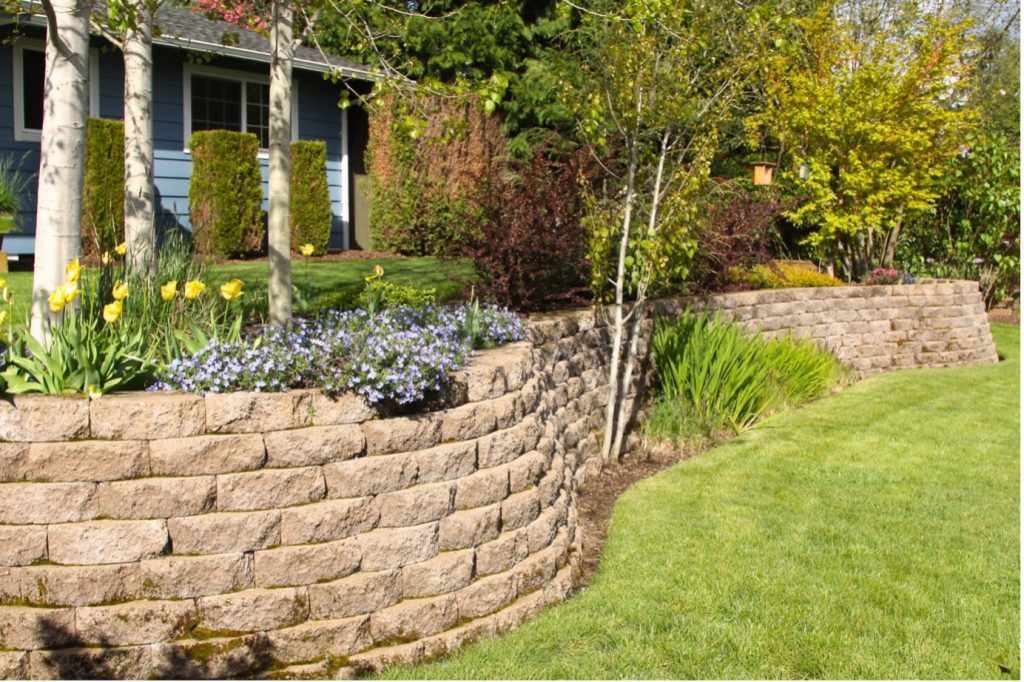Retaining walls, often unassuming yet incredibly impactful, play a pivotal role in landscaping and construction projects. These sturdy structures are not only essential for soil stabilization and erosion prevention but also contribute to the creation of usable spaces on uneven terrain. As one gazes upon these walls, it’s not just the functional aspects that stand out; their aesthetic appeal and seamless integration into the landscape are equally impressive. Behind this seemingly simple structure lie a series of key elements that, when harmoniously combined, result in a well-constructed retaining wall that stands the test of time.
Understanding the Purpose and Types of Retaining Walls
Retaining walls are more than mere barriers; they are a marriage of function and form. With a primary objective of stabilizing soil and preventing erosion, retaining walls hold back the forces of nature, creating level areas where none existed before. The versatility of retaining walls is reflected in the variety of types available. Gravity walls, cantilever walls, anchored walls – each designed with a distinct purpose in mind. The choice of the right type depends on the site conditions and the specific demands of the project.
Site Evaluation and Planning
Before a single stone is laid, the site must undergo thorough evaluation and meticulous planning. Soil analysis is the foundation of this process, determining soil characteristics like compaction, drainage, and bearing capacity. This knowledge informs the design and engineering of the wall. Equally important is addressing drainage considerations. Proper drainage prevents water buildup behind the wall, mitigating the risk of hydrostatic pressure-induced damage. Engaging professional engineers in the design phase is crucial, as they consider factors such as wall height, soil pressure, and surcharge load to ensure structural integrity and safety.
Material Selection
The materials chosen for a retaining wall are paramount. The material not only defines the wall’s appearance but also influences its longevity and functionality. Concrete blocks, natural stone, timber, and concrete are common choices. Concrete blocks offer durability, natural stone adds timeless charm, timber lends a rustic feel, and concrete provides versatility. The quality of the chosen material directly impacts the wall’s lifespan and its ability to withstand the elements over time.

Construction Techniques
Constructing a retaining wall is an intricate process that demands precision and attention to detail. A solid foundation is non-negotiable, as it bears the weight of the entire structure. Proper excavation, leveling, and compaction lay the groundwork for stability. As the wall takes shape, careful alignment and interlocking of blocks or stones ensure its strength. The installation process, step by step, transforms raw materials into a formidable and visually appealing structure.
Reinforcement and Backfill
Underneath the surface, reinforcement materials play a crucial role in the integrity of the retaining wall. Geogrid and geotextile are used to distribute the loads exerted by the soil and to prevent soil erosion. These unobtrusive materials act as silent guardians, reinforcing the wall from within. Additionally, proper backfilling techniques are essential. They not only alleviate soil pressure but also contribute to effective drainage. The importance of compacting the backfill cannot be overstated, as settling and shifting over time can compromise the wall’s stability.
Proper Drainage System
A robust drainage system is the unsung hero of a well-constructed retaining wall. Behind the scenes, weep holes, drainage pipes, and gravel backfill work in tandem to manage hydrostatic pressure and prevent water buildup behind the wall. By channelling water away from the structure, these components ensure that the wall remains free from excessive moisture – a key factor in maintaining its longevity and integrity.

Aesthetic Considerations
Retaining walls go beyond their intended purpose and are also aesthetically pleasing. Landscapes may be transformed by these constructions into aesthetically pleasing and useful locations. The advantages include terraced landscapes, tiered gardens, and improved curb appeal, to name a few. The wall’s look may be improved by adding ornamental components like coping, caps, and veneers, which will ensure that it merges in with the rest of the architectural plan.
Maintenance and Long-Term Care
Even the most durable walls need upkeep and maintenance to maintain their dependability. It is crucial to do routine maintenance and inspection. To stop future damage, cracks, shifting, and drainage problems must be immediately fixed. A well-kept retaining wall serves as a tribute to the investment made in its building throughout time, providing both structural support and aesthetic improvement.
Conclusion
Retaining walls occupy a distinctive position in the world of building. Their modest elegance conceals the complex network of components that come together to form a structure that is not only useful but also beautiful. Every stage, from the initial site assessment through the material selection, building methods, and drainage systems, is crucial. To successfully complete a retaining wall project, careful planning, skilled execution, and a dedication to quality are essential. Marecki Masonry is a reliable partner for these kinds of projects. Marecki Masonry, with a history of skill and workmanship, guarantees that every retaining wall they build is a tribute to quality and toughness, flawlessly fusing aesthetics and practicality.

